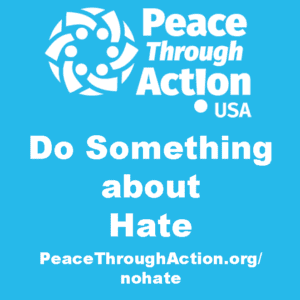What is hate?
Hate is defined as intense hostility and aversion usually deriving from fear, anger, or sense of injury.[1] Hate is a threat to peaceful societies and often results in serious offenses such as hate speech, hate crimes, and hate-based movements.
[1] Hate. (n.d.). [internet]. https://www.merriam-webster.com/dictionary/hate. Viewed December 25, 2017.
How widespread is hate in the United States?
- Each year from 2004 to 2015, US residents experienced an average of 250,000 hate crime victimizations.[1]
- One in four violent hate crimes involved a weapon during 2006 – 2015.1
- Hate language is reported as part of 98.7 percent of hate crimes, whether it be the sole act of hate or as a counterpart to other acts.2
- The Southern Poverty Law Center has documented an explosive rise in the number of hate groups since the turn of the century, rising 49.8 percent from 1999 to 2016.[2]
- In 2016, there were 917 documented hate groups operating across the country.2
[1] Masucci, M. & Langton, L. (2017). Hate crime victimization, 2004-2015. Washington D.C.: The Bureau of Justice Statistics of the U.S. Department of Justice. Publication No.: NCJ 250653.
[2] Southern Poverty Law Center. (n.d.). Hate map. [internet.] https://www.splcenter.org/hate-map. Viewed Retrieved January 16, 2018.
What culture changes and public policies are necessary for preventing hate?
Culturally, we must engage individuals and groups to recognize and confront identity-based prejudices that motivate hate. We must also introduce restorative justice processes into communities to help heal the damage caused by hate.
With regard to public policies, state institutions and nongovernmental organizations should continue the rigorous monitoring of hate groups and condemnation of their acts. Police should receive training on identifying hate crimes and organizing services for victims. Also, public authorities should make hate crime reporting more accessible, such as user-friendly online technology, including reporting apps.[1]
[1] Walters, M., Brown, R., & Wiedlitzka, S. (2016). Preventing hate crime: emerging practices and recommendations for the effective management of criminal justice interventions. Sussex, UK: Sussex Crime Research Centre.
What practical solutions are effective for preventing hate?
Implementation of practical peaceful solutions such as bias reduction, dialogue groups, empathy and compassion cultivation, and restorative justice processes can be effective at preventing hate before it starts or becomes a chronic condition. Learn more about these practical peaceful solutions in our Choose Peaceful Practices series of information pages.
What can I do to prevent or stop hate?
- Expand safe spaces—Host dialogues about hate. These spaces should encourage open conversations while having intervention strategies in place. They can include discussion groups, book clubs, library gatherings, or even online spaces such as Facebook groups or online community discussion boards.
- Speak up and act out against hate—If we don’t act out against hate, it will persist. Speak out against acts of hate, sign petitions, and attend vigils and rallies. Repair acts of hate-fueled vandalism. Offer whatever skills or resources that are available to you, such as printing fliers or giving employees off to attend peaceful protests and rallies.
- Create alternatives to hate rallies—Do not attend hate rallies to protest them. They make the event look larger and burden law enforcement with protecting hatemongers from otherwise law-abiding citizens. Instead, hold alternative events, such as unity rallies, community forums, or parades at the same hour, some distance away, emphasizing strength in community and diversity. These events provide a safe space for community members and distract attention and impact from the hate rally.[1]
- Report acts of hate—Report hate incidents you experience or witness to a local or state public authority. Record the details as soon as the incident occurs, as to best remember later. Speak to the press if you feel comfortable as your story can be a powerful motivator to others.
- In Case of Emergency—If you are experiencing or witnessing an emergency, such as a hate incident, call 911 or try to get to a location where others can observe your distress and intervene.
[1] Southern Poverty Law Center. (2018). Ten ways to fight hate: a community response guide. [internet]. https://www.splcenter.org/20170814/ten-ways-fight-hate-community-response-guide#an alternative, viewed January 18, 2018.
Where can I find statistics about hate?
- The Federal Bureau of Investigation collects and reports hate crimes statistics.
- The Southern Poverty Law Center’s Hate Map tracks activity of hate groups across the US.
- The U.S. Dept. of Justice’s Hate Crime Victimization Report presents data on hate crimes from 2004 to 2015.
Where else might I go to learn more about hate?
Nonprofit organizations, research centers, and/or think tank organizations with expertise in hate include:
- Southern Poverty Law Center fights hate and bigotry and to seeks justice for the most vulnerable members of society.
- The Anti-Defamation League combats anti-Semitism, all forms of hate, and secures justice.
- National Association for the Advancement of Colored People (NAACP) ensures political, educational, social, and economic equality and to eliminate race-based discrimination.
Page Author: CV Viverito (volunteer)
Have a suggested improvement to this information sheet? Send it to inbox@peacethroughaction.org
Do Something Right Away to Increase Peace
Subscribe to our YouTube channel
Give money to support Peace Through Action’s mission delivery activities
Choose opportunities to take part in our #PeaceBeginsWithWe campaign

